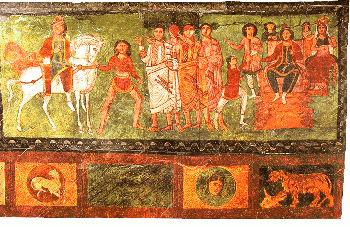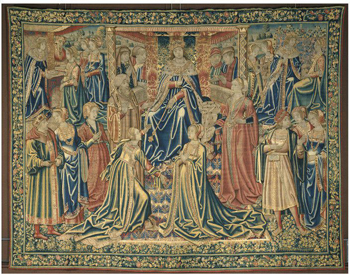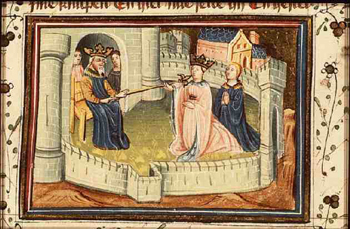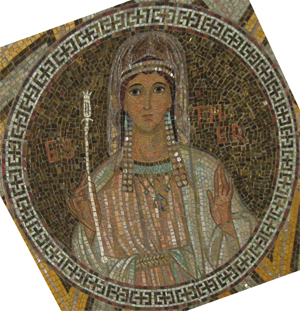For Sunday September 27, 2015
Lectionary Readings (Revised Common Lectionary, Year B)
Esther 7:1–6, 9–10, 9:20–22 or Numbers 11:4–6, 10–16, 24–29
Psalm 124 or Psalm 19:7–14
James 5:13–20
Mark 9:38–50
In late 1946, three Bedouin shepherds tossed some rocks into a cave, heard pottery break, and discovered seven ancient scrolls. This was at a place called Qumran, about a mile from the north west corner of the Dead Sea. That accidental discovery turned out to be one of the greatest archaeological finds in modern times.
When archaeologists excavated Qumran, they found a treasure trove of ancient artifacts — coins, pottery, cloth, rope, baskets, a sophisticated water system, etc. Next to the excavated site is a cemetery with over a thousand graves.
What most captured the imagination of scholars and the public were the scrolls found at Qumran. Among the tens of thousands of fragments that were found in eleven caves, all within a radius of about two miles, 972 discrete texts were identified.
The sectarian Essenes who had fled to the desert were clearly a text-oriented community. Normative, authoritative, and divinely-inspired texts were central to their way of life.
 |
|
Wood panel of the Book of Esther from the Dura-Europos synagogue, 244 CE.
|
Among the broad diversity of texts discovered at Qumran — legal, liturgical, political, etc., about 200 of the scrolls were manuscripts from every single book of today's Jewish Bible.
Every book, that is, except for Esther, this week's lectionary. The text-collecting Essenes had no need for Esther.
What accounts for this glaring omission among a people who were conspicuously devoted to holy books? Why did the Essenes exclude Esther?
Esther has flummoxed Jewish and Christian interpreters alike for a number of reasons. The story takes place among Jewish exiles in Persia, not in more familiar locations like Palestine, Egypt or Babylon. The plot is explicitly secular, and not even remotely sacred.
According to the story, an orphan named Esther hid her Jewish identity, married the pagan king Xerxes (or Ahasuerus) of Persia, and became the queen. Through a series of bizarre circumstances, she and her cousin Mordecai thwarted the plot of Haman to annihilate the Jews. The tables were turned, and it was Haman and his family who were executed, and the Jews who exacted revenge on their enemies.
Esther is notable for what it never mentions — God, the Torah, Jerusalem, or the temple. By one count, the pagan king is mentioned 190 times. The plot hinges on intrigue, hatred, deceit and the revenge by the Jews, who massacred 75,000 of their enemies.
 |
|
Belgian tapestry of Esther, 1510-1520.
|
There's no mention of ritual purity, religious customs like the Sabbath or prayer or dietary laws, or the Hebrew sense of justice, mercy, and kindness. And when both Mordecai and Esther send letters to the scattered Jews to celebrate their victory, they send it under the auspices of the Persian court and not that of any Jewish leader.
From the perspective of the author of Esther, writes Michael Satlow, "it is at least plausible that Persian Jews could live a full and satisfying life close to the royal court with no knowledge whatsoever of any authoritative writings and perhaps even without any distinctive religious customs."
No wonder the Essenes neglected Esther, and that no other book in the Bible refers to it.
And no wonder there was an effort to upgrade the original Hebrew text of Esther with a newly sacred makeover.
As it turns out, the later Greek version of Esther in the Septuagint interspersed 107 new verses throughout six places in the original 167 Hebrew verses. That's a massive makeover. The KJV calls these "The Additions to the Book of Esther." Indeed.
When Jerome translated the Bible into Latin in the fifth century, he recognized these Greek additions for what they were — later corruptions of the original Hebrew, and so he excised them and placed them after the end of Esther 10:3.
But the efforts to rehabilitate Esther didn't stop there.
In the 13th-century, the Catholic English Cardinal and Archbishop of Canterbury, Stephen Langston, gave these six Greek interpolations, now collected at the end of Esther, chapter and verse numbers, as if they were a continuation of the original Hebrew — which they weren't. Instead of Esther ending at 10:3, as in the original Hebrew, his version of Esther continues on from 10:4 to 16:24.
 |
|
Azor master (ca. 1430), Esther before Ahasuerus, Koninklijke Bibliotheek, The Hague.
|
And what a makeover. There's no question about the purpose of the spurious Greek material. It wants to sacralize a secular story with a more traditionally religious story line. The later material "significantly alters" everything about the original Esther, say Watson E. Mills and Richard F. Wilson — its "protagonist, plot, piety and purpose."
The very first verse of the Greek additions (10:4) says, “And Mordecai said, 'These things have come from God.'” In the later material, God is mentioned more than 50 times. Unlike in the original Hebrew, in the new-n-improved version, Esther and Mordecai pray to God.
And so, Esther has had both Jewish and Christian detractors who objected to its inclusion in the Bible. In his Table Talk, Martin Luther was so hostile to it that he said, "I would it did not exist." Calvin never wrote a commentary on it.
 |
|
Esther, mosaic from The Dormition Church on Mount Zion in Jerusalem.
|
Nonetheless, every year since the story of Esther, Jews around the world have observed the Feast of Purim that's mentioned only in Esther. It's the "month when their sorrow was turned to joy and their mourning into a day of celebration" (Esther 9:22). The feast includes two readings of the book of Esther — on the first night of Purim and then the next morning.
The most common takeaway from Esther is that it's a story about God's hidden providence. He works in unspoken and unknown ways. He's present even when he's absent. I like this interpretation. I believe it's true.
Still, this reading feels a little too easy and breezy. Esther makes me think more deeply about the absence of God, as in the poem Via Negativa by the Welsh poet and Anglican priest R.S. Thomas (1913–2000):
Why no! I never thought other than
That God is that great absence
In our lives, the empty silence
Within, the place where we go
Seeking, not in hope to
Arrive or find. He keeps the interstices
In our knowledge, the darkness
Between stars. His are the echoes
We follow, the footprints he has just
Left. We put our hands in
His side hoping to find
It warm. We look at people
And places as though he had looked
At them, too; but miss the reflection.
Finally, Esther reminds me how tempting it is to edit my own story in order to make myself look better, more spiritual and pious, like the later Greek version did to the original Hebrew.
It would be liberating to tell the truth about ourselves — to our own selves and to others. But as Frederick Buechner writes, "that is often just what we also fear more than anything else… And so little by little we come to accept instead the highly edited version which we put forth in hope that the world will find it more acceptable than the real thing."
Thank God for Esther. She didn't need a makeover. Neither do you or I.
Image credits: (1) Wikipedia.org; (2) kinneretstern.com; (3) IAmTheWithness.com; and (4) Wikipedia.org.





